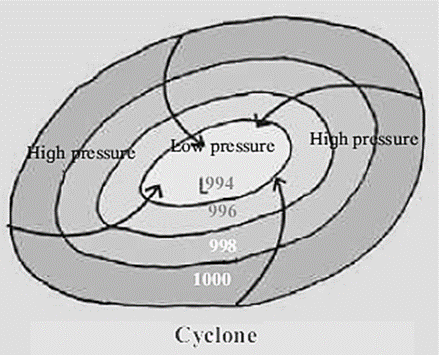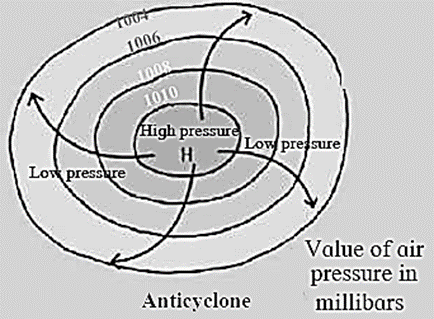Winds
Maharashtra Board-Class-7th-Geography-Chapter-5
Notes
Topics to be learn :
|
Introduction :
- The movement of air is called wind.
- We feel the wind but cannot see it.
- The air pressure is not uniform across the earth’s surface. Air moves from high pressure areas towards low pressure areas in a horizontal manner. Winds are generated due to this horizontal movement of air.
- The extent of difference in the air pressure affects the velocity of the wind.
- If there is less difference in the pressure, wind blow with less velocity.
- It there is more difference in the pressure, wind blow with high velocity.
- Wind velocity is measured in the units of knots or kilometres per hour.
Rotation of the earth and the direction of winds :
- The direction of winds is influenced by the rotation of the earth.
- Winds get deflected towards the right of their original direction in the northern hemisphere and towards the left of their original direction in the southern hemisphere.
- The rotation of the earth from the west to the east causes this change in the original direction of the winds.
Types of winds :
On the basis of the direction of blowing, the duration, the regions covered and the condition of air, winds are classified into the following 3 types :
- planetary winds
- local winds and
- seasonal winds.
Mostly, winds are known by the direction from which they blow or by region in which they blow.
(1) Planetary winds :
Some winds blow regularly on the earth from high to low pressure belts throughout the year. These winds cover a large portion of the earth, hence these are called planetary winds. For example, the Easterlies, the Westerlies and the Polar winds.
(i) Easterlies :
- In both the hemispheres, the winds that blow from the mid-latitudinal high pressure belt (between 25° and 35° parallels) to the equatorial low pressure belt (between 0° and 5° parallels) are called the Easterlies.
- The original direction of Easterlies changes due to the rotation of the earth.
- In the northern hemisphere, they blow from the northeast to the southwest whereas in the southern hemisphere they blow from the southeast to the northwest. (iv) These winds coming from both sides converge near the equatorial calm belt.
(ii) Westerlies :
- In both the hemispheres, the winds that blow from the mid-latitudinal high pressure belt (between 25° and 35° parallels) to the sub-polar low pressure belt (between 55° and 65° parallels) are called the Westerlies.
- The original direction of the Westerlies changes due to the rotation of the earth.
- In the northern hemisphere, they blow from southwest to the northeast whereas in the southern hemisphere they blow from the northwest to the southeast.
(iii) Polar winds :
- In both the hemispheres, the winds that blow from the polar highpressure belt (between 80° and 90° parallels) to the sub-polar low pressure belt (between 55°and 65° parallels) are called the polar winds.
- Polar winds generally blow from the east to the west.
(2) Local winds :
- The winds that blow for a short duration of time, originate in specific regions and blow over limited area are called local Winds.
- Besides these, winds blow under particular conditions in different areas. These are also called local winds. For example, Loo, Simoom, Chinook (Snow water), Mistral, Bora, Pampero, Fohn (Foehn), etc.
Breezes :
(i) Valley breezes :
- Valley breezes are the winds that blow from the valley to the mountain during the day (after sunrise).
- During the day, the air on the mountain heats up faster than the air in the valley zone. The air pressure is lower on the mountain and higher in the valley at this moment.
- As a result, the cool valley air is pushed upwards towards the mountain, while the hot and light mountain air rushes downwards towards the valley. Valley breezes are created in this manner.
(ii) Mountain breezes :
- Mountain breezes are the winds that blow from the mountain to the valley at night (after sunset).
- The air atop the mountains swiftly cools down at night, while the air in the valley zone remains warmer. The air pressure is higher on the mountain and lower in the valley at this moment.
- As a result, the cool mountain air rushes down towards the valley, while the hot and light valley air is pushed upwards towards the mountain. The mountain breezes are created in this manner.
Sea breezes :
- The winds that blow from the sea to the land during a day are called sea breezes.
- During the day, the land in the coastal areas gets heated faster than the seawater. So, the air on the land gets heated and the air pressure on the land decreases.
- On the other hand, during the day, sea-water gets heated slowly. So, the air on the sea-water gets heated slowly and the air pressure on the sea-water remains high. As its effect, during the day, winds blow from the sea to the land. In this way the sea breezes are formed.
Land breezes :
- The winds that blow from the land to the sea at night are called land breezes,
- At night, the land in the coastal areas cools down faster than the sea-water. So, the air on the land cools down and the air pressure on the land increases.
- On the other hand, at night sea-water cools down slowly. So, the air on the sea-water cools down slowly and the air pressure on the sea-water remains low. As its effect, at night, winds blow from the land to the sea. In this way, the land breezes are formed.
Major local winds in the world :

(3) Seasonal winds (Monsoon) :
- Monsoon winds are generated by the uneven heating of land and ocean during the seasons, and their impacts are most noticeable in Southeast Asia, East Africa, and North Australia.
- Monsoon winds have an impact on the Indian subcontinent's summer and winter seasons.
- Apart from summer and winter, the Indian subcontinent has monsoon (rainy) and receding monsoon seasons as a result of these winds.
- Monsoon winds are in fact sea and land breezes blowing on a large scale.
- Most of the precipitation in the Indian subcontinent is the effect of moon winds. After crossing the equator, they blow from the south-west towards the Indian subcontinent during the period from June to September. These winds are called the south-west monsoons winds. They are full of moisture.
- From September to December, because of the low pressure area developing near the equator, winds blow from the Indian subcontinent towards equator. These winds are called the north-east monsoon winds. They are dry winds.
Cyclones :

- Cyclonic conditions are created when a low pressure area is surrounded by high pressure areas.
- On the weather maps, the centre of cyclone is represented by the letter ‘L’.
- A cyclone system moves from one place to another. Cyclones are also known as storms or cyclonic storms.
- Cyclones occurring in the western part of the Pacific Ocean along the coasts of Japan, China, Philippines, etc. are known as ‘Typhoons’.
- The cyclones in the Caribbean Sea are known as ‘Hurricanes’.
- Cyclones also originate in the temperate zone. But they are not so powerful and hence are not destructive.
Effects of cyclones :
- Due to cyclones the sky becomes cloudy.
- Cyclonic Winds blow heavily with a very high velocity leading to heavy rains.
- Cyclonic winds may prove to be destructive as they may cause loss of property and life near coastal regions.
Anticyclones :

- Anticyclonic conditions are created when a high pressure area is surrounded by low pressure areas. In such situation, winds; blow form the centre towards the surrounding areas in a circular manner.
- On the weather maps, the centre of anticyclone is represented by the letter ‘H’.
Click on below link to get PDF from store
MSBSHSE-Class-7-Geography-Chapter-5-Winds-Notes
MSBSHSE-Class-7-Geography-Chapter-5-Winds-Solutions
MSBSHSE-Class-7-Geography-Chapter-5-Winds-Book
All Chapter Class-7-Geography Notes Set (11-PDF) Rs. 35-Buy
All Chapter Class-7-Geogarphy Solutions Set (10-PDF) Rs. 28-Buy
All Chapter Class-7-Geogarphy Notes + Solutions Set (21-PDF) Rs. 55-Buy
All Notes -Social Science (History_Civic+Geography-30-PDF) Rs. 80-Buy
All Solutions -Social Science (History_Civic+Geography-29-PDF) Rs. 72-Buy
All Notes + Solutions -Social Science (History_Civic+Geography-59-PDF) Rs. 135-Buy
Useful links for Class 7
| Main Page : Class 7th MSBSHSE – Geography - All chapters notes, solutions, videos, test, pdf.
Previous Chapter : Chapter 4 :Air Pressure - Online Notes Next Chapter : Chapter-6-Natural Regions-Online Notes |